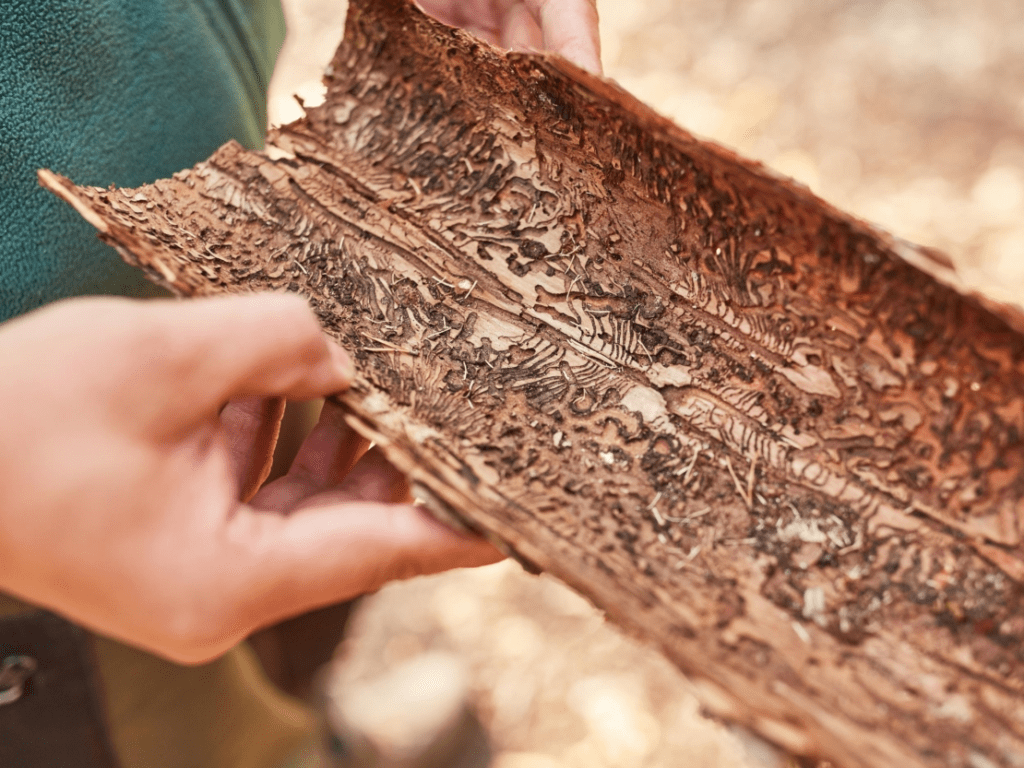Damage caused by bark beetles is mainly known from reports from the forestry industry. However, the small beetles not only attack large stands of spruce in the forest, they can also cause considerable damage in gardens.
The damage ranges from the browning of individual branches on trees or shrubs to the death of entire plants. It is often difficult to identify bark beetle infestation as the cause.
Contents
Bark beetles – weakened plants most at risk
Bark beetles enter plants through boreholes and primarily attack weakened or stressed woody plants. Actually, the beetles are part of the natural cycle in which old wood is decomposed and the nutrients from it are available to young plants for their growth. In addition, the decomposition of old wood creates space for new plants.
However, if the beetles attack weakened specimens in a conifer hedge in the garden, this is very annoying. The resulting gaps have to be filled with suitable new plants and the bark beetles could damage other hedge plants. It is therefore worthwhile to look out for infestation signs at an early stage.
The increase in bark beetle infestation in parks and gardens is attributed, among other things, to rising temperatures and lower precipitation.
These environmental influences result in longer dry periods and cause plants to be stressed and their defences to be lower. In addition, climate change may cause plant-damaging insects to appear more often in regions that were previously too cool for them, due to increasing warming.
Bark beetle species and characteristics
The letterpress beetle (Ips typographus) and the copper engraver (Pityogenes chalcographus) are bark beetle species that are mainly known as forestry pests. The letterpress beetle is about five millimetres in size, the copper engraver is similar to the letterpress beetle, but is only three millimetres long and its wings are copper-coloured on the upper side. The beetles mainly attack spruces, other bark beetle species prefer beech or fruit trees, for example.
In gardens, damage by bark beetles of the genus Phloeosinus is observed more and more frequently, especially on trees of life (Thuja) and false cypresses (Chamaecyparis). The thuja splinter beetle (Phloeosinus thujae), often also called thuja bark beetle, and the two-coloured juniper bark beetle (Phloeosinus aubei) also attack junipers (Juniperus) and other cypress plants (Cupressaceae). The brown-black beetles are difficult to recognise because they are only about 1.5 to 2.5 millimetres in size.
Host plants and pests
As weak parasites, bark beetles prefer stressed or weakened plants, but they can also attack healthy plants.
However, strong woody plants that are well supplied with water are better able to defend themselves against infestation. They form resin drops in the areas damaged by a bark beetle as a defence against the invader.
At first glance, an infestation of a tree with bark beetles is not obvious. The beetles are tiny and the death of individual branches or the entire plants could also be due to fungal diseases or drought damage.
The development of bark beetles
Basically, two typical damage patterns can be observed, which have to do with the life cycle of the beetles:
The young beetles attack the fresh shoots of their host plants in summer. Their feeding tunnels are about one centimetre long. As a result of this so-called maturation feeding, the twigs turn sallow and brown the next spring. It can often be seen that the shoots, which are about five to 20 centimetres long, snap off at the base due to the infestation. They break off easily when touched or by wind.
Towards the end of the summer, the second and much more dangerous step in the development of the bark beetles takes place: they bore into the bark to lay eggs there. Two-armed, several centimetre long “mother tunnels” develop. The larvae that emerge from the eggs form a multitude of feeding tunnels, which lead to the severe damage to the plants.
The animals overwinter in the larval stage in the bark. In spring, the bark beetles leave the tree by drilling roundish holes about the size of a pinhead into the bark. Boring dust can be found under these holes.

The feeding damage and its consequences for the plant
Characteristics of an infestation can be:
Boreholes
Resin flow
Boring powder leakage
snapping off of individual twigsDanger from the larvae
Maturation feeding by bark beetles is usually not fatal for the plants. The feeding of the larvae under the bark, however, is very dangerous. It can lead to the death of the affected trees, as it damages crucial areas: the cambium, which is responsible for the growth of the bark, as well as the conduits in the trunk, which are vital for the transport of water and nutrients.
Prevention and control of the bark beetle
The thujabork beetle and also the juniper bark beetle cannot be controlled in the garden with chemical agents. As bark breeders, the larvae of these beetles are also protected from the direct effect of insecticides by the bark of the trees. Instead, it is important to strengthen the plants with appropriate measures or – if they are already infested – to prevent them from spreading.
For many woody plants, the effects of climate change mean severe drought stress. Weakened trees are particularly susceptible to diseases as well as to bark beetles and other pests. Especially shallow-rooted woody plants as well as freshly planted trees and shrubs will have a hard time if longer dry periods become more frequent.
To avoid drought stress, it is therefore important to have a good water supply during periods of low rainfall. The adequate supply of nutrients also contributes to the resistance of the woody plants. Site-appropriate plant selection is also important.
Other ways of ensuring that bark beetles do not cause as much damage as possible: Look out for symptoms of infestation at an early stage and quickly remove and destroy infested branches or plants. It is also important to check neighbouring trees and shrubs for bark beetle infestation.

